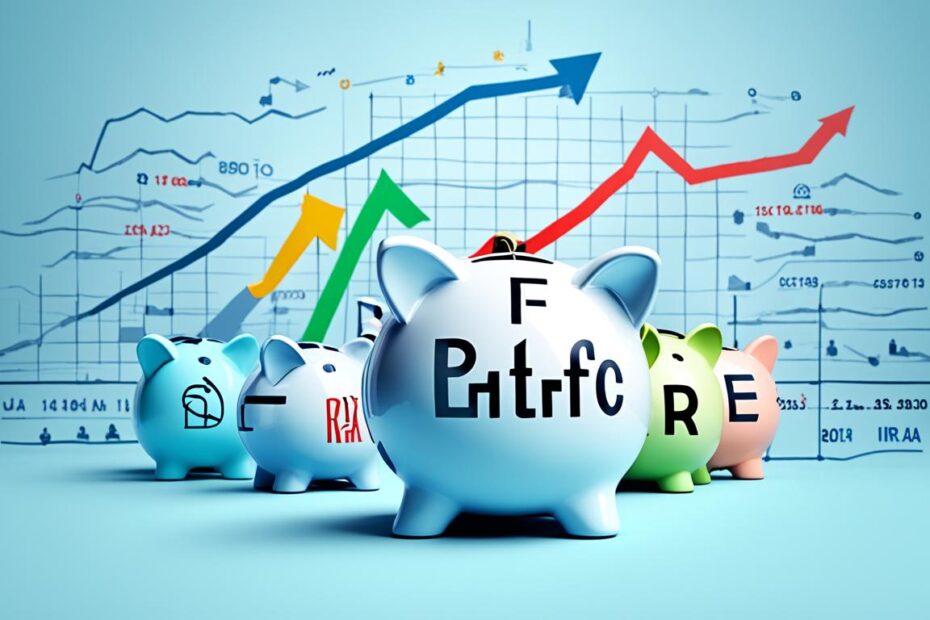Planning for retirement means mixing equity and fixed income assets. When you’re near retirement, it’s smart to focus more on safer options like bonds. The bond market is bigger than the stock market, valued at $129.8 trillion in 2022. Below are top bond ETFs for your Roth IRA.
Key Takeaways:
- Include a mix of equity and fixed income investments in your retirement portfolio.
- As you approach retirement, consider shifting your allocation towards safer investments, like bonds.
- The bond market is larger than the stock market, with a global market value of $129.8 trillion in 2022.
- Investing in bond ETFs can be a smart choice for your Roth IRA, providing diversification and potential income generation.
- Consider factors like investment-grade bonds, expense ratios, and past performance when choosing the best bond ETF for your Roth IRA.
iShares Core U.S. Aggregate Bond ETF (AGG)
The iShares Core U.S. Aggregate Bond ETF covers many U.S. investment-grade bonds. It mainly puts money in AAA-rated bonds, meaning they are very high-quality. This ETF is great for Roth IRA investors who want to add bonds to their mix, with an expense ratio of only 0.03%.
It’s important to include bonds in any investment plan. They add a steady income and lower the overall risk. By investing in various high-quality bonds, this ETF helps Roth IRA owners build their savings over time.
Over five years, this ETF has given back an average of 0.3% yearly and a 3.3% yield. While these numbers aren’t big, they show that you can rely on the ETF for stable payments. This is perfect for Roth IRA holders who want to save and earn income without a lot of risk.
As a budget-friendly choice, the iShares Core U.S. Aggregate Bond ETF is a smart pick for Roth IRA users. Its low 0.03% expense ratio means more of your money goes to work for you.
To see more details about the iShares Core U.S. Aggregate Bond ETF, check the chart below:
Performance Overview:
- 5-year annualized return: 0.3%
- Yield: 3.3%
- Expense ratio: 0.03%
This ETF is a good fit for anyone wanting to mix bonds into their portfolio wisely. By looking at how it performs and its costs, investors can pick a fund that helps them reach their financial dreams.
Vanguard Total Bond Market ETF (BND)
The Vanguard Total Bond Market ETF is perfect for those who want to invest in the taxable investment-grade U.S. bond market. This ETF tracks a broad bond index. It reflects the variety of U.S. bonds that are seen as investment-grade.
About two-thirds of its investments are in U.S. government bonds. This makes the ETF stable and safe for investors. Government bonds are usually less risky. They’re a good choice for anyone wanting a safe investment.
The Vanguard Total Bond Market ETF has shown a 0.4% yearly return over five years. While not high, this is normal for bonds. Bonds mainly offer income, not fast growth.
This ETF has a 3.2% yield, which is quite good. Investors can rely on getting regular income from it. This is especially nice for those looking for passive income.
The ETF’s expense ratio is very low, at 0.03%. This means investors won’t lose much money to fees. They can keep more of their returns.
The Vanguard Total Bond Market ETF focuses on the U.S. bond market. It’s a favorite for many investors. It gives a mix of stability, income, and low costs. This makes it a good fit for Roth IRA investors.
Fidelity U.S. Bond Index Fund (FXNAX)
The Fidelity U.S. Bond Index Fund offers a reliable path for investors. It lets them tap into the Bloomberg Barclays U.S. Aggregate Bond Index. At least 80% of this fund’s assets are in the index. This helps the fund track the total return of the debt securities it holds.
This fund has seen a 0.3% return over five years. It offers a 3.1% yield. This shows it can provide an income while working to preserve your money.
The Fidelity U.S. Bond Index Fund stands out with its 0.025% expense ratio. This is much lower than other bond funds. It’s a good choice for those who want to boost their Roth IRA returns without high costs.
Fidelity is known for its skill in managing bonds. This means investors trust they are getting the best management possible. They can benefit from the fund’s experienced strategies.
Adding the Fidelity U.S. Bond Index Fund to your Roth IRA brings you a mix of fixed income investments. They closely mirror the Bloomberg Barclays U.S. Aggregate Bond Index.
Thanks to its strong track record, low cost, and expert management, the Fidelity U.S. Bond Index Fund is a smart pick for those in the bond market via their Roth IRAs.
Vanguard Short-Term Corporate Bond ETF (VCSH)
The Vanguard Short-Term Corporate Bond ETF is a top pick for those interested in corporate bonds. It mainly invests in bonds that mature in one to five years. This helps investors earn money now with lower risk.
It has shown great results over the last five years. An average yearly return of 1.9% and a 3.2% yield highlight its performance. This means it’s good for steady income and short-term bonds.
It focuses on bonds from strong, stable companies. These companies are seen as less likely to fail, so your income is more secure.
This ETF is very cost-effective with its low 0.04% expense ratio. It means you keep more of the money you make, boosting your returns.
Choosing this ETF also spreads your risk by investing in different sectors. This lessens the impact of any single bond doing poorly.
The Vanguard Short-Term Corporate Bond ETF (VCSH) is a great option for those wanting to invest in high-quality bonds. Its short-term focus, strong performance, and low costs make it a favorite for earning income with less risk.
iShares Floating Rate Bond ETF (FLOT)
The iShares Floating Rate Bond ETF is well-liked by investors. It gives exposure to U.S. investment-grade floating rate bonds. These bonds adjust their interest payments when rates change, a plus during rate hikes.
It has shown a 5-year annualized return of 2.6% and a yield of 5.8%. This is good news for investors. Also, with an expense ratio of 0.15%, more earnings stay with the investor.
This ETF adds variety to your portfolio’s fixed income section. By including these floating rate bonds, you can better balance risk while handling interest rate changes.
For a Roth IRA, understanding your risk tolerance and goals is key. The iShares Floating Rate Bond ETF focuses on U.S. investment-grade floating rate bonds. This means it can help with earning income and guarding against rate hikes.
Fidelity Investment Grade Bond Fund (FBNDX)
The Fidelity Investment Grade Bond Fund (FBNDX) aims to give investors a good income. It’s managed actively by Fidelity’s team, who pick and look after many safe investment-grade bonds.
It mainly aims to invest in safe, low-default risk bonds. These include corporate, government, and mortgage securities. At least 80% of its money goes into these kinds of bonds.
This fund looks to make money through bond interest. Its managers watch the market to get the best returns while keeping things safe.
FBNDX has averaged a 1.2% yearly return over the last 5 years. Remember, bond fund profits can change with interest rates and market ups and downs.

Diverse Portfolio of Investment-Grade Bonds
FBNDX gives a mix of various investment-grade bonds. This mix helps lower the risk, as it’s not all in one type. It includes different corporate and government bonds for safety.
Active Management for Risk and Performance
Fidelity’s expert managers work hard to lower risk and find good returns. They look at market changes and check the bonds’ safety. Then, they change the fund’s mix based on research and know-how. This way, the fund can do well even when the market shifts.
Expense Ratio and Accessibility
FBNDX has a 0.45% expense ratio, which is a good deal for an actively managed fund. A lower expense ratio means more of the returns go to investors. This fund lets you keep more of what you earn.
You can buy into FBNDX through Fidelity’s online site or certain brokerages. Just keep an eye on fees and how much you need to start investing.
In a nutshell, the Fidelity Investment Grade Bond Fund (FBNDX) is a strong choice. It offers a wide range of safe bonds and is managed by Fidelity’s pros. It focuses on making good money for investors while keeping risks in check. Those looking at safe, income-producing bonds should consider FBNDX.
Schwab U.S. Aggregate Bond Index Fund (SWAGX)
The Schwab U.S. Aggregate Bond Index Fund is great for those with a Roth IRA. It lets investors be part of the U.S. investment-grade bond market. This means you get a wide range of top-quality bonds.
There’s no need for a big starting investment. Plus, the fund’s cost is very low, at 0.04%. This makes it easy and cheap to add bonds to your Roth IRA, whether it’s your first or you’ve been investing for a while.
In the last five years, its returns averaged at 0.2% yearly. It also pays a 3.1% yield, giving investors extra earnings from their Roth IRA.
The fund takes care of investing in the whole U.S. investment-grade bond market. This means you don’t have to pick and watch over lots of separate bonds. It’s great for those wanting a simpler, hands-off investment style.
To wrap it up, the Schwab U.S. Aggregate Bond Index Fund (SWAGX) is a smart and affordable choice for Roth IRA investors. It offers a wide range, low costs, and steady earnings. For a varied, fixed income investment, this fund is a strong pick.
Where to Buy Bond Funds
Bond funds are a favorite among investors. They offer a diverse, well-managed way to invest in bonds. If you’re thinking of adding bond funds to your investments, consider a few places.
Online Brokerages
Buying bond funds online is easy and accessible. You can pick from many fund options, each with different strategies and risks. These platforms come with tools and real-time data to help you decide wisely.
You’ll find it simple to compare funds and see how they’re doing. Plus, making a purchase is just a click away.
Mutual Funds
Although many online brokers have bond ETFs, not all have mutual funds. To see if a broker has the mutual fund you want, use their screening tool. This tool shows you all the details you need to know before investing.
Online brokers can give you access to both bond ETFs and mutual funds. Use the tools they offer to research and to wisely diversify your investments.
Benefits of Bond ETFs for Roth IRAs
Bond ETFs offer many gains for Roth IRA investors.
- Diversification: Investing in Bond ETFs is diversification. With a variety of bonds, the risk tied to one bond is less significant.
- Professional Management: It lets experts handle your investments. This means you don’t have to worry about picking each bond.
- Income Generation: They can make money regularly. This is perfect for Roth IRAs because you won’t pay taxes on this growth.
Having a diverse, well-managed, and income-earning portfolio, bond ETFs are great for Roth IRAs. They make your Roth IRA more stable and possibly grow more over time.
Consider the Image Below:

Best Bond ETFs for Different Bond Categories
When choosing a bond ETF for your Roth IRA, think about different types of bonds. This helps you make your investment mix more varied. For American stocks, ETFs like IVV, VOO, SPLG, SPTM, ITOT, VTI, and BKLC are top choices. They offer a mix of American stocks. This mix can help your Roth IRA grow.
The BKAG ETF is the top choice for Roth IRA bond investments. It follows the Bloomberg Barclays US Aggregate Total Return Index. This index covers a wide range of high-quality American bonds. Investing in BKAG lets you own many different bonds. This can help bring steady income into your Roth IRA.
It’s also important to look beyond just the U.S. for Roth IRA investing. The SPDW ETF stands out for this. It gives you a mix of stocks from around the world. Investing globally can help you diversify. Plus, it gives you a chance to grow your investment.
No matter if you pick American stocks, bonds, or global investments, the ETFs mentioned here can make your Roth IRA more diverse. Think about what you want from your investments and how much risk you can take. With that in mind, these ETFs can be good choices for different types of bonds.
Summary:
- For U.S. stocks, top-performing ETFs for Roth IRAs include IVV, VOO, SPLG, SPTM, ITOT, VTI, and BKLC.
- The best bond ETF for Roth IRAs is BKAG, tracking the Bloomberg Barclays US Aggregate Total Return Index.
- For global investing, consider the SPDW ETF for exposure to international stocks.
Conclusion
Choosing the right bond ETF for your Roth IRA is very important. Think about the types of bonds it includes, whether it helps you spread out your money, how much it costs, and how it’s done in the past. The options shared in this piece cover many bond types and could be a good pick for your Roth IRA.
It’s key to think about how much risk you’re okay with and what you want to achieve with your investment. Bond ETFs come with benefits like making regular income and being run by experts. These can be appealing for those investing in a Roth IRA.
Mixing bond ETFs in your investments can help balance your money. It’s a way to make sure you have a stable nest egg for your retirement. Take your time and pick a bond ETF that matches your plan.
FAQ
What should I consider when choosing a bond ETF for my Roth IRA?
For your Roth IRA, think about these key points. Look at the type of bonds it holds, how varied they are. You should also consider costs and how well it’s done in the past. Choosing wisely can boost your retirement fund and match your plans for the future.
What are some of the best bond ETFs for Roth IRAs?
The best bond ETFs for Roth IRAs offer a mix of different bonds. Consider these options: iShares AGG, Vanguard BND, Fidelity’s FXNAX, Vanguard’s VCSH, iShares FLOT, Fidelity’s FBNDX, and Schwab’s SWAGX. They cover various bond types and may suit what you’re looking for in your Roth IRA.
Where can I buy bond funds?
You can get bond funds from online brokers, who offer many choices. They also provide bond ETFs. Remember, not all brokers have the same mutual funds. It’s smart to use a broker’s search tool to check if your desired fund can be bought with them.
What are the benefits of bond ETFs for Roth IRAs?
Bond ETFs offer a mix of good points. They help spread your investment across many bonds. Since they are managed by pros, you don’t need to pick each bond yourself. They can also pay out money regularly, which is great for a Roth IRA. Overall, they are a solid choice for your Roth IRA needs.
